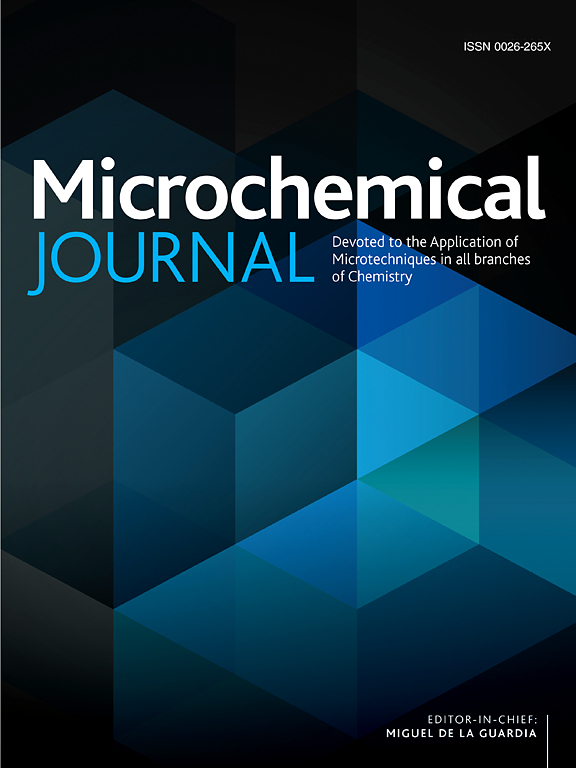单cu原子锚定共价有机骨架作为对乙酰氨基酚可穿戴柔性电化学传感器
IF 4.9
2区 化学
Q1 CHEMISTRY, ANALYTICAL
引用次数: 0
摘要
本文提出了一种基于Cu单原子催化剂(SACs)锚定在联吡啶-共价有机框架(COF)电极上的非酶电化学传感器的可穿戴柔性贴片,用于人体汗液中对乙酰氨基酚(AP)的特异性检测。电极修饰材料为Cu单原子催化材料(Cu- tpbpy)。双功能TpBpy通过丰富且组织良好的N-N螯合位点结合单个Cu原子,同时由于其多孔结构和活性N位点,它作为活性宿主特异性识别/吸附AP。得到的Cu- tpbpy具有原子分散的Cu位点,由于电子传递效率提高,结合能和吸附能降低,对AP具有较高的电化学活性。密度泛函理论计算进一步表明,铜单原子锚定在TpBpy上比单独锚定在TpBpy上对AP有更好的吸附,具有更低的结合能,更高的选择性和灵敏度。基于Cu-TpBpy的可穿戴柔性贴片能够实时、准确地检测人体汗液中的AP,线性范围为0.3µM-5µM,检测限为13 nM,具有良好的稳定性和重复性。本工作开发了一种高灵敏度的可穿戴柔性贴片非酶传感方法。本文章由计算机程序翻译,如有差异,请以英文原文为准。
Single-Cu-atom anchoring on covalent organic framework as a wearable flexible electrochemical sensor for acetaminophen
In this paper, a wearable flexible patch featuring a non-enzymatic electrochemical sensor based on Cu single-atom catalysts (SACs) anchored on bipyridine-covalent organic framework (COF) electrode was proposed for specific detection of acetaminophen (AP) in human sweat. The electrode modified material is Cu single atom catalytic material (Cu-TpBpy). The bifunctional TpBpy acts as a support for binding individual Cu atoms through abundant and well-organized N-N chelating sites, while simultaneously serving as an active host for specific recognition/adsorption of AP due to its porous structure and active N sites. The resulting Cu-TpBpy with atomically dispersed Cu sites demonstrated high electrochemical activity for AP, attributed to enhanced electron transfer efficiency and reduced binding and adsorption energies. Density functional theory calculations further reveal that the Cu single-atom anchoring on TpBpy provides superior adsorption of AP than TpBpy alone, resulting in lower binding energy, and higher selectivity and sensitivity. The wearable flexible patch, based on Cu-TpBpy, enabled real-time and accurate detection of AP in human sweat and achieved a linear range of 0.3 µM-5 µM and a limit of detection of 13 nM, with satisfied stability and repeatability. This work developed a highly sensitive non-enzymatic sensing method for wearable flexible patches.
求助全文
通过发布文献求助,成功后即可免费获取论文全文。
去求助
来源期刊

Microchemical Journal
化学-分析化学
CiteScore
8.70
自引率
8.30%
发文量
1131
审稿时长
1.9 months
期刊介绍:
The Microchemical Journal is a peer reviewed journal devoted to all aspects and phases of analytical chemistry and chemical analysis. The Microchemical Journal publishes articles which are at the forefront of modern analytical chemistry and cover innovations in the techniques to the finest possible limits. This includes fundamental aspects, instrumentation, new developments, innovative and novel methods and applications including environmental and clinical field.
Traditional classical analytical methods such as spectrophotometry and titrimetry as well as established instrumentation methods such as flame and graphite furnace atomic absorption spectrometry, gas chromatography, and modified glassy or carbon electrode electrochemical methods will be considered, provided they show significant improvements and novelty compared to the established methods.
 求助内容:
求助内容: 应助结果提醒方式:
应助结果提醒方式:


